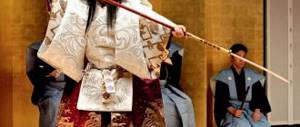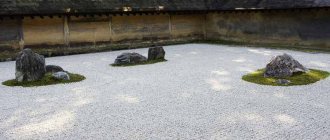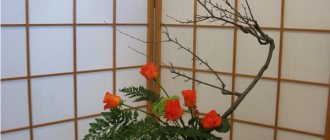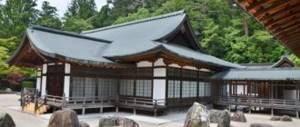The Japan rock garden, or karesansui (literally meaning dry landscape), dates back to the Muromachi period (1336 - 1573), and is still part of Japan's aesthetic and cultural heritage. In those days, it was believed that gods lived in places with a large accumulation of stones, as a result of which the stone began to symbolize something sacred, divine. It was in order to get closer to the gods that such a tradition as decorating the garden with stones appeared in Japan. Later, the rock gardens became a place for meditation for Buddhist monks.
What does history say?
The symbolic meaning of the stone has ancient roots. The religious schools of philosophy Zen Buddhism and Confucianism endow this part of inanimate nature with energy that carries calm, harmony and serenity. In Japan, the stone became an object of worship. This is where the idea of stone gardens originated.
At first, small compositions were made at monasteries and temples for contemplation and meditation. Today it is an element of the East in landscape design. But the Japanese still believe that such a miniature near the house will help achieve harmony with the world, avoid everyday problems and fuss.
Philosophy
Every detail of the composition is based on the teachings of Zen. It says that the world is as man sees it. By concentrating on a frozen picture, you can be alone with nature and hear your inner voice.
Photo: Japanese house
Zen masters claimed that if you look long at a stone lying on the sand with waves drawn around it, you can see how it slowly sinks into the water.
The classic version of a garden composition made of stones is created according to the principles of Feng Shui. It is based on 4 elements: air, earth, water and fire. The role of the last element can be played by decorative lanterns. If it is not possible to equip an artificial reservoir, sand with curved lines and circles in the form of waves will be an alternative.
The traditional picture is completed by ceramic figures, fences, and low-growing plants. Nearby there is a Japanese-style gazebo or pergola.
When creating a Japanese garden, it is important not to disturb the symmetry of the arrangement of parts and to avoid cluttering the space.
The meaning of stones
The second name for this part of landscape design is karesansui. Translation: dry water and mountains.
Each element individually is responsible for a certain symbol:
- small pebbles, gravel or sand are water;
- flat stone - earth;
- high cobblestone - sky;
- massive rock pile – island or mountains.
In combination, they symbolize the grace of simplicity, due to which a different meaning is given to the surrounding world, and an analysis of values occurs.
Symbolism
The correct arrangement of stones in space is a real philosophy, the result of which can be a work of art - a finished sekitei. It represents a kind of world model:
- large stones - the personification of islands, mountains, large hills, rocks, cliffs;
- sand or pebble filling - the water surrounding them.
At the same time, the stones reflect the masculine principle, Yang energy, and symbolic water – the feminine Yin energy. All other decorations like paths, bridges, lanterns are just background.
The rock garden is a symbol:
- freedom;
- endless spaces;
- the perfection of nature;
- grace in simplicity.
Composition details
The selection of garden components is carried out very carefully, since all parts must be in harmony with each other.
Photo: park in Japan
Natural stone
The selection of these elements is carried out taking into account the shape, size, color and texture.
Their arrangement should suggest that the surface diagram is only a small part of the picture for contemplation, the larger one is located inside.
The Japanese rock garden uses volcanic rocks:
- granite;
- tuff;
- basalt;
- andesite;
- chlorite.
Photo: composition of stones
Stones are distinguished by shape:
- curved;
- flat;
- low vertical;
- recumbent;
- statues.
The Japanese identify a stone with a living being and believe that it has a face, behavioral dynamics and character.
Therefore, when creating such gardens, designers distinguish between stones that look up or down, run away, catch up, or lean against.
Photo: rock garden in the courtyard of the house
To make a high-quality composition, it is better to enlist the support of a specialist. If you lack experience, laying stones may not work and will look ridiculous.
Fencing
An important element of the picture. It means a desire for tranquility, a desire for privacy, which is why the fence is traditionally made opaque.
An interesting solution to create a fence from bamboo, tree branches, and climbing plants. You can carefully lay out partitions from cobblestones.
Lanterns
A decorative component responsible for lighting the garden.
Photo: stone lantern
Based on their appearance and purpose, there are several types:
- Ikekomi-gata. They are considered hidden lanterns. A stream of light is directed into the earth.
- Tachi-gata. Pedestal products. Their height ranges from 1 m to 3 m. They are used in large gardens. They are located in places where guests are received.
- Oki-gata. Small lanterns. They place it near the path leading to the gazebo or house.
- Yakimi-gata. Lanterns with a stone or concrete base. They have a square or round roof. To make the light flow softer, the body is made of frosted glass.
It is recommended to purchase lanterns made from natural materials so as not to disturb the harmony of the picture. Suitable pumice, wood, ceramics, stone.
Towers
This is an additional part of the garden, so such a figure should not be central to the composition. In accordance with this, its size is also selected.
Most often it is located near the tsukubai - a traditional Japanese mini-fountain. Material: stone. The tower has an odd number of tiers. Shape – four-, six-, octagonal or round.
Tsukubai
It is a bowl made of stone up to 30 cm high. Previously used in Japan for washing hands before the tea ceremony. Now it serves a purely decorative function. Install on a flat, low area.
Water enters the bowl through copper, PVC pipes, and hoses running under the ground.
Photo: stone bowl filled with spring water
If a tsukubai is fixed without a drainage system, the flowing water will form a fast stream. In this case, you should not place the product high - this is fraught with eroded sand and pebbles.
Decorative additions
In the garden, not only the blocks themselves are important, but also additional elements: fences, plants, bridges, patterns in the sand.
Patterns in the sand - a recognizable element of a rock garden - are made with special rakes. The drawing should have a thoughtful pattern that will harmoniously combine with the idea of the composition. So, straight lines are the surface of the water, calm, circles around the elements are waves absorbing rocks, and curved and winding lines are a seething stream.
The fence is a symbol of privacy. As a rule, it is located on one or both sides of the site. Made from opaque materials such as bamboo, concrete and stone.
Tsukubai is a bowl into which water flows through special channels or pipes. This is a symbol of movement. The element dilutes the static nature of the garden.
An important point is lighting at night. Lanterns made from natural materials - pumice, wood or stone - are installed in the garden.
The paths symbolize a long journey in life. They should not have a clear geometric shape. Winding paths lead to every part of the garden. Tracks should not stand out from the overall composition. As a rule, they are made from natural material or irregularly shaped bricks; you can use dim paving slabs. When creating a path pattern, no squares should be formed.
Bridges are a symbol of the transition to the next stage of life and knowledge . It is preferable to use a bridge made of a stone monolith.
How to place stones on the site
Even when creating a simple garden, it is worth considering several features:
- All components of the picture are collected in groups. This is a good masking of individual defects.
- Preference is given to natural stones that have been exposed to precipitation, winds, and temperature changes. Their rounded features will make the composition softer and easier to perceive.
- Elements that are similar in color are selected.
- A prerequisite is an odd number of stones. Their number should be a multiple of three, five, best of all – fifteen pieces.
- The principle of a triad operates inside the painting: three stones in each group. It is important that the main group is combined with the landscape design, while others complement it.
- The presence of a point of contemplation in the composition. It is selected based on what time of day the owners plan to spend in the Japanese garden. Often the garden is located so that it is on the north side.
- Harmonious location relative to the entire site.
- Asymmetry of components.
- Maintaining line balance. There should be more horizontally installed stones than vertical ones.
- Contrast of free and filled space.
If the details of the composition are located correctly, then no matter which side a person stands on, he will see all the stones except the fifteenth. In Eastern philosophy, it is believed that only a select few who have comprehended the essence of the universe can contemplate the picture in full.
Stylistics
The minimalist garden will appeal to thoughtful lovers of secluded relaxation. If you want to create a rock garden with your own hands, there are a few key points to consider. Firstly, it is “emptiness”. This is exactly the impression you get when you first see a rock garden. Unlike European ones, the Japanese garden is not filled to its maximum capacity.
It is necessary to determine the main point of contemplation towards which the entire garden will be oriented. Observation hours are also taken into account in advance. To avoid the blinding sun, it is preferable to place the viewing point on the north side. The main object of observation is located in the eastern or western part of the garden, depending on the chosen time of contemplation.
The Japanese garden is asymmetrical. Stones should be of different shapes and sizes. There is no need to place them parallel to each other. Objects are positioned so that they are clearly visible from any viewing point, taking into account the heptagonal geometric network of lines. If there is a water feature on the site, it is necessary to consider the reflection of the garden elements.
Creating a Japanese rock garden with your own hands
Owners of suburban areas who want to try their hand at organizing part of the landscape design need to be patient and be extremely careful.
Photo: Japanese-style composition on a summer cottage
No permits are required to compose the composition, but having a plan for the painting will simplify the assembly process. Therefore, it is better to take a pencil and schematically depict the future decoration of the estate.
The procedure is as follows:
- The area is cleared of debris and weeds.
- The area is being leveled.
- The top layer of soil is removed to a depth of 15 cm.
- To strengthen it, bricks are laid around the perimeter or boards are attached.
- Sand up to 5 cm thick is poured onto the bottom.
- The remaining space is filled with gravel, pebbles, and white sand.
- To compact the contents, fill it with 1 bucket of water per 2 m2 of garden area.
- Stones are placed. They should take a stable position, be slightly pressed into the sand.
- Circular or wavy lines are made from stones, imitating water.
- The rest of the surface is leveled with a rake in vertical and horizontal stripes.
The composition will be complemented by a small perimeter fence, plants, tsukubai, and lanterns.
Photo gallery of famous gardens
Let's consider several options for the arrangement of the elements of the picture.
Ryoanji Temple Rock Garden
Reanji is a monument of Zen Buddhism. Created in the XIV-XVI centuries in Kyoto. No matter how many historians try, the mystery of the composition still remains unsolved. This is a rectangular area filled with gravel. On top of it are wavy lines that play the role of the water element. But the basis of the picture is fifteen stones, divided into five groups.
Previously, the description indicated the lack of a clear structure in Reanji. But years of research have shown that this is a stone painting of tree branches, revealed to the beholder only from a certain angle.
Zen Garden in Karlovy Vary
Created on June 16, 1998 on the outskirts of a Czech resort town. Named in honor of Ghana Baltz, the wife of a German doctor who, at the request of the Emperor of Japan, laid the foundations of medicine in this country. Architect: Kinji Nomura.
The composition is made in the shape of a circle, divided in the middle by a line. This is the border between yin and yang. The garden is strewn with white gravel, symbolizing the ocean. One of the stones is shaped like a ship. The small cobblestone depicts Hana Baltz. A lantern is installed in the center of the composition - a symbol of light and help for those who have lost their way. Vertical statues are analogues of menhirs. This picture tells a whole story and attracts the attention of tourists from different countries.
Saiho-ji
Saiho-ji, also known as Koke-dera, or "Temple of Moss". The garden is famous for its moss-covered cover, and is one of the most famous gardens in all of Japan. The gardens here have been designated as a "Special Place of Scenic Beauty" in Japan and are arranged as a circular promenade centered on the Golden Pond. The garden also has three tea houses where you can relax and reflect on the world. The lush green garden of Saiho-ji takes you to another world with its special beauty and tranquility. Before visiting, be sure to make a reservation to visit the garden, as entry to the garden requires a reservation.
Related article: Flight of the gibbon at Khao Kheo Zoo and other entertainment in Thailand.
Heian Jingu
Heian Jingu, built to commemorate the city's 1100th anniversary, has one of the finest traditional landscape designs among Kyoto's landmark gardens. The spacious gardens contrast beautifully with the colorful temple buildings. The garden was created in a style reminiscent of the Heian period, which lasted from 794-1185. It has a large pond with a Chinese style bridge. The bright red range of colors that predominates in the architecture of the temple makes it lush and vibrant in all four seasons. In addition, in spring you can see lush cherry blossoms here, and water lilies and irises delight the eyes of visitors throughout the summer.
Tenryu-ji
Tenryu-ji Garden is located in Arashiyama, on the western outskirts of the city, and is one of Kyoto's greatest Zen temples. A breathtaking Japanese garden for strolling, framed by the picturesque Arashiyama Mountains, which seem to be part of the garden and create a view reminiscent of a picturesque painting, in which you can feel part of this harmonious world.
Tenryu-ji
The garden, with its circular promenade around Sogen Pond, has been named a "Special Place of Scenic Beauty" in Japan. The best time to visit is spring, as this is when the cherry blossoms wake up and give their guests a unique opportunity to observe their lush blossoms. Autumn is also a suitable season for visiting the garden, when the variegated colors of autumn foliage will give a special atmosphere of comfort and tranquility.
Rock garden
Another name is alpine slide. It can be installed on a natural slope or an artificial mound of stones can be created. Flowers and shrubs are planted between the cobblestones. Previously, the list of plants for planting in rock gardens was limited to bulbous and low-growing perennials. Today, the owners assemble a composition from the plants they like.
The beauty of the eastern stone garden fascinates and brings inner harmony to the contemplator. This is an excellent choice for garden owners who want to see a piece of meditative Japanese culture in their garden.








